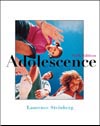 |
1 |  | 
is the practice of grouping students in school by age, begun in the mid-1800s. |
 |
 |
2 |  | 
The rapid growth in teen population between 1955 and 1975, a trend that repeated itself in the 1990s, was caused by a dramatic increase in the size of one particular cohort: the generation. |
 |
 |
3 |  | 
James Coleman, in his book The Adolescent Society (1961), argued that one manifestation of the was that motivation for academic success was significantly lower among adolescents than were the aspirations held for them by their parents. |
 |
 |
4 |  | 
Most teens report that their friends pressure them to . |
 |
 |
5 |  | 
When the behaviors that are acceptable in society vary from one person to another, that society is said to have norms. |
 |
 |
6 |  | 
When everyone in the society is expected to adhere to the same standards of behavior, that society is said to have norms. |
 |
 |
7 |  | 
In , society changes enough from generation to generation that children/adolescents need to teach each other some things that adults cannot teach them. |
 |
 |
8 |  | 
In children need to teach adults many things, as society changes even more rapidly. |
 |
 |
9 |  | 
In , very little changes over time in what an adult needs to know; hence, adults can teach children all they need. |
 |
 |
10 |  | 
Childhood is typified by , in which children engage in much of their peer interaction with individuals of the same sex. |
 |
 |
11 |  | 
are small groups of 2-12 peers, usually same sex and age. |
 |
 |
12 |  | 
are large groups of adolescents that are defined by reputation and stereotypes. |
 |
 |
13 |  | 
A research technique called has been used to study the structure of adolescent peer groups; the researcher (investigator) actually joins in the activities of the teens to gain first-hand knowledge of events and individuals. |
 |
 |
14 |  | 
Crowds serve as a ; they provide individuals with an identity in the eyes of peers. |
 |
 |
15 |  | 
An is an in-depth, qualitative study conducted as the researcher spends considerable time immersed in the culture being studied. |
 |
 |
16 |  | 
are deviant peer groups that can be identified by name and symbols (colors, hand signs). |
 |
 |
17 |  | 
Adolescents also segregate themselves into cliques based on family income and educational background, the two variables that comprise what is called . |
 |
 |
18 |  | 
are undesirable outcomes from well-intentioned treatments. |
 |
 |
19 |  | 
Nicki Crick has studied the aggressive tendencies of girls; they are more likely to use - intended to harm others through deliberate manipulation of their social standing and social relationships. |
 |
 |
20 |  | 
Aggressive children tend to have a - they tend to perceive that others have negative attitudes and intentions toward them - and they respond to perceived "slights" with aggression. |
 |



 2002 McGraw-Hill Higher Education
2002 McGraw-Hill Higher Education